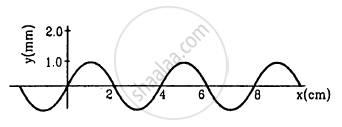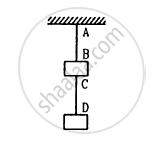Advertisements
Advertisements
Question
A transverse wave of amplitude 0⋅50 mm and frequency 100 Hz is produced on a wire stretched to a tension of 100 N. If the wave speed is 100 m s−1, what average power is the source transmitting to the wire?
Solution
Given,
Amplitude of the transverse wave, r = 0.5 mm
\[= 0 . 5 \times {10}^{- 3} m\]
Frequency, f = 100 Hz
Tension, T = 100 N
Wave speed, v = 100 m/s
Thus, we have:
\[\nu = \sqrt{\left( \frac{T}{m} \right)}\]
\[ \Rightarrow \nu^2 = \left( \frac{T}{m} \right)\]
\[ \Rightarrow m = \frac{T}{\nu^2} = \frac{100}{\left( 100 \r = 0 . 01 kg/m\]
Average power of the source:
\[ P_{avg} = 2 \pi^2 m\nu r^2 f^2 \]
\[ = 2 \left( 3 . 14 \right)^2 \left( 0 . 01 \right) \times 100 \times \left( 0 . 5 \times {10}^{- 3} \right)^2 \times \left( 100 \right)\]
\[ = 2 \times 9 . 86 \times 0 . 25 \times {10}^{- 6} \times {10}^4 \]
\[ = 19 . 7 \times 0 . 0025 = 0 . 049 W\]
\[ = 49 \times {10}^{- 3} W = 49 mW\]
APPEARS IN
RELATED QUESTIONS
When longitudinal wave is incident at the boundary of denser medium, then............................
- compression reflects as a compression.
- compression reflects as a rarefaction.
- rarefaction reflects as a compression.
- longitudinal wave reflects as transverse wave.
When a transverse wave on a string is reflected from the free end, the phase change produced is ..............
(a) zero rad
(b) ` pi/2 ` rad
(c) `(3pi)/4` rad
(d) `pi` rad
A transverse harmonic wave on a string is described by y(x, t) = 3.0 sin (36 t + 0.018 x + π/4)
Where x and y are in cm and t in s. The positive direction of x is from left to right.
(a) Is this a travelling wave or a stationary wave?
If it is travelling, what are the speed and direction of its propagation?
(b) What are its amplitude and frequency?
(c) What is the initial phase at the origin?
(d) What is the least distance between two successive crests in the wave?
Given below are some functions of x and t to represent the displacement (transverse or longitudinal) of an elastic wave. State which of these represent (i) a traveling wave, (ii) a stationary wave or (iii) none at all:
y = cos x sin t + cos 2x sin 2t
Explain why (or how): Bats can ascertain distances, directions, nature, and sizes of the obstacles without any “eyes”,
Explain why (or how) Solids can support both longitudinal and transverse waves, but only longitudinal waves can propagate in gases
A transverse wave is produced on a stretched string 0.9 m long and fixed at its ends. Find the speed of the transverse wave, when the string vibrates while emitting the second overtone of frequency 324 Hz.
You are walking along a seashore and a mild wind is blowing. Is the motion of air a wave motion?
A transverse wave travels along the Z-axis. The particles of the medium must move
Figure shows a plot of the transverse displacements of the particles of a string at t = 0 through which a travelling wave is passing in the positive x-direction. The wave speed is 20 cm s−1. Find (a) the amplitude, (b) the wavelength, (c) the wave number and (d) the frequency of the wave.

Consider the following statements about sound passing through a gas.
(A) The pressure of the gas at a point oscillates in time.
(B) The position of a small layer of the gas oscillates in time.
A transverse wave described by \[y = \left( 0 \cdot 02 m \right) \sin \left( 1 \cdot 0 m^{- 1} \right) x + \left( 30 s^{- 1} \right)t\] propagates on a stretched string having a linear mass density of \[1 \cdot 2 \times {10}^{- 4} kg m^{- 1}\] the tension in the string.
Two blocks each having a mass of 3⋅2 kg are connected by a wire CD and the system is suspended from the ceiling by another wire AB (See following figure). The linear mass density of the wire AB is 10 g m−1 and that of CD is 8 g m−1. Find the speed of a transverse wave pulse produced in AB and CD.

A heavy but uniform rope of length L is suspended from a ceiling. (a) Write the velocity of a transverse wave travelling on the string as a function of the distance from the lower end. (b) If the rope is given a sudden sideways jerk at the bottom, how long will it take for the pulse to reach the ceiling? (c) A particle is dropped from the ceiling at the instant the bottom end is given the jerk. Where will the particle meet the pulse?
The equation of a standing wave, produced on a string fixed at both ends, is
\[y = \left( 0 \cdot 4 cm \right) \sin \left[ \left( 0 \cdot 314 {cm}^{- 1} \right) x \right] \cos \left[ \left( 600\pi s^{- 1} \right) t \right]\]
What could be the smallest length of the string?
